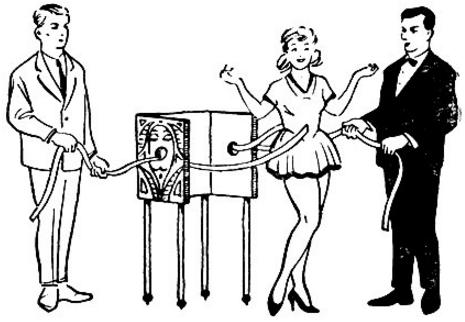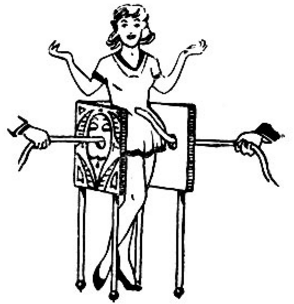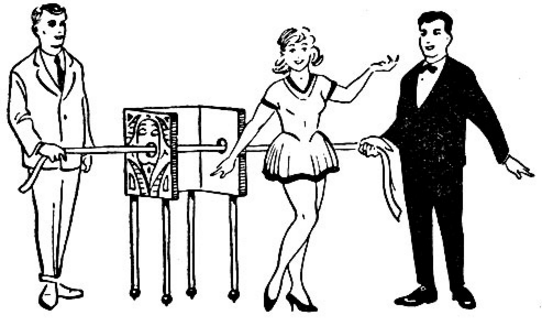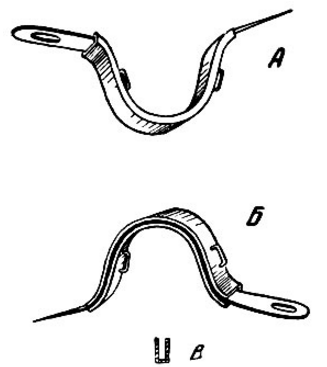
|
|
EFFECTIVE FOCUSES AND THEIR CLUES Piercing with a steel needle (with a descent from the tape). Focus Secret
Directory / Spectacular tricks and their clues Focus Description: The magician shows a large steel needle and, returning to the table, “accidentally” drops it on the floor. The needle sticks into the floor. Having taken it out, the performer places it on the table and takes the tape from the table, which he shows to the audience. Returning to the stage, the performer takes the needle handed to him by an assistant and threads a ribbon through the eye of the needle. The assistant brings out a small, high-legged, three-leaf screen. The assistant comes out and stands in front of the screen. The performer, approaching the assistant, pierces her through with a needle (Fig. 90).
Having removed the needle from the tape, he gives it to his assistant. Then the illusionist asks one person from the audience to come to him, takes one end of the tape for himself, and gives the other to the viewer to hold. The tape is pulled back and forth through the assistant. Then the performer threads one end of the ribbon through the right (from the audience) hole in the right side of the screen and asks the spectator to thread the other end into the left flap, which he does (Fig. 91).
The assistant comes behind the screen and holds both hands on top of the screen (Fig. 92), and the performer and the audience pull the tape and pull it right and left. They pull the tape tight, and the assistant suddenly comes out from behind the screen. It came off the tape with which it was “stitched” right through.
The performer and the audience hold the ribbon taut (Fig. 93), and the assistant, bowing, goes backstage.
Props: Corset-case with a slit along its length for the release of the tape. A large steel needle is 70-75 cm long and about 1,5 cm thick (a needle from the third program we described is used). An imitation needle made of steel tape has the same length, width and shape as the needle itself (used from the third program). The satin ribbon is the same as in the third program, that is, 4-5 cm wide and 2 m long. Three-leaf screen on high legs, as in Fig. 91, 92 and 93. The size of the screen is made according to the height of the assistant. Focus secret: The secret of this number is described in great detail in the focus Piercing with a steel needle. However, the corset-case is somewhat different from the one we described earlier, namely: it is not a closed tube, but a tube with a cut along its length. Through this cut, the tape, threaded with an imitation needle, can completely come out of the corset. This corset is shown in Fig. 110, where A is a top view of the corset with a needle (imitation) threaded through it; B - bottom view; the cross-section shows a needle (imitation), bent along the curve of the corset; B - cut across the corset.
The assistant's costume should be such that from the puncture (the point where the needle enters) to the waist in front and behind and along the entire length of the corset, the tape can freely come out from under the costume, that is, have a disguised cut in front, side and back. After the performer “pierces through” the assistant with a needle (imitation), passes through the tape and removes the needle from the tape (see Fig. 90), he gives it to the assistant, and he himself, calling one person from the audience, pulls the tape through, proving that the assistant pierced through. The performer lifts the tape above the exit hole so that it does not come out of the corset slot, and the assistant makes sure that this does not happen at the entrance hole. Then the tape is threaded through both holes in the screen to the right and left of the assistant. The holes in the screen should be slightly lower than the inlet and outlet holes of the corset. When the spectator and performer pull the ribbon tightly, the assistant rises slightly on her toes and, turning to face the performer (to the right of the audience), brings the entrance hole of the corset to the right (from the audience) hole in the screen (to do this, she rises slightly). Thus, she brings the ribbon down from the corset slit and, sharply turning her face from the performer to the spectator holding the ribbon, finally pulls the ribbon out from under the costume. If this is done clearly, then none of the viewers will even notice the moment of leaving the tape. And since the assistant keeps her hands raised all the time, the release from the tape becomes completely incomprehensible and mysterious for the audience. A well-made suit and a disguised cut for the tape to exit enhance the impression. The assistant puts the corset on the left side. If for some reason the performer is unable to achieve a clear, lightning-fast release of the assistant from the tape, then to disguise this moment, you can attach a fourth flap of the screen, which will hide the moment the tape comes out; however, we do not recommend doing this, as the effect is significantly reduced. With a three-leaf screen, everything happens in front of the audience. No one touches the screen with their hands after the ribbon is threaded through it, and the assistant turns only once, first towards the performer (to the right of the audience), and then in the opposite direction - towards the spectator. Since the screen does not have any secrets, it can stand in the corner on the stage before and after the performance of the number. The needle exchange is quite clear: first the performer shows a real needle and, as if accidentally, drops it on the floor. The needle is stuck into the floor, and the viewer can clearly see that the needle is real; then the illusionist places the needle on the table and takes the imitation needle from the assistant, who made the substitution while the performer showed the tape to the audience. When threading the ribbon into the screen, the assistant has enough time to completely unnoticeably exchange the imitation needle for a real needle and hold it casually in his hands. Then, when the assistant removes the screen, the needle may “accidentally” fall out of his hands; by its knock, the audience will understand that this is a real massive needle, and will be convinced that everything was done with it (you should not stick the needle into the floor a second time, as was done the first time). Author: Vadimov A.A.
Machine for thinning flowers in gardens
02.05.2024 Advanced Infrared Microscope
02.05.2024 Air trap for insects
01.05.2024
▪ Robotic London Underground trains ▪ Video surveillance in Moscow schools
▪ section of the site Dosimeters. Selection of articles ▪ article by Lawrence Durrell. Famous aphorisms ▪ article Which animal is theoretically immortal? Detailed answer ▪ snowcat article. Personal transport
Home page | Library | Articles | Website map | Site Reviews www.diagram.com.ua |






 Arabic
Arabic Bengali
Bengali Chinese
Chinese English
English French
French German
German Hebrew
Hebrew Hindi
Hindi Italian
Italian Japanese
Japanese Korean
Korean Malay
Malay Polish
Polish Portuguese
Portuguese Spanish
Spanish Turkish
Turkish Ukrainian
Ukrainian Vietnamese
Vietnamese






 See other articles Section
See other articles Section 